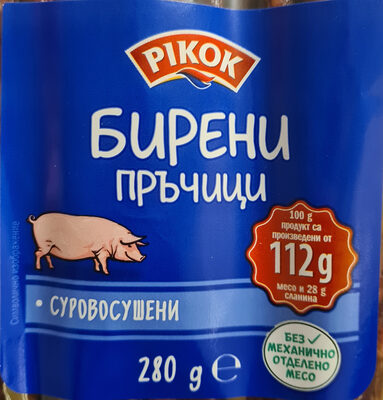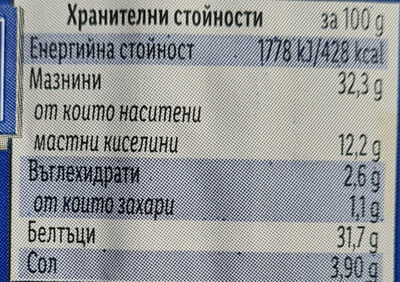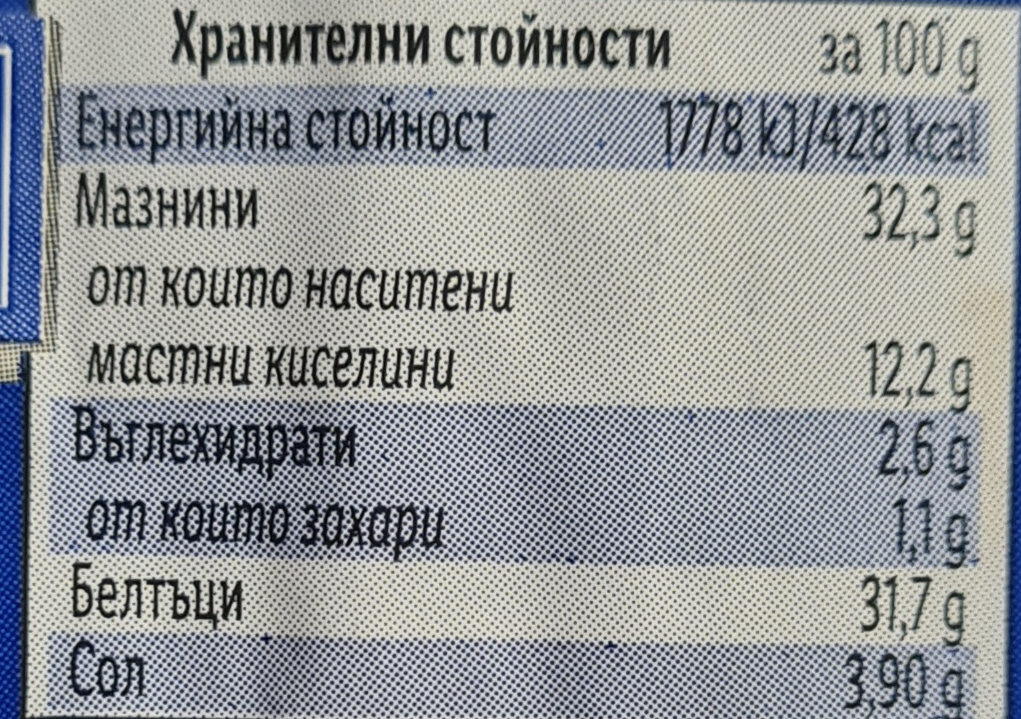Help us make food transparency the norm!
As a non-profit organization, we depend on your donations to continue informing consumers around the world about what they eat.
The food revolution starts with you!
Бирени пръчици - Pikok - 280 g
Бирени пръчици - Pikok - 280 g
Ambiguous barcode: This product has a Restricted Circulation Number barcode for products within a company. This means that different producers and stores can use the same barcode for different products.
×
This product page is not complete. You can help to complete it by editing it and adding more data from the photos we have, or by taking more photos using the app for Android or iPhone/iPad. Thank you!
×
Barcode: 20529437
Quantity: 280 g
Packaging: Plastic, Other-plastics
Brands: Pikok
Categories: Meats and their products, Meats, Prepared meats, Pork and its products, Sausages, Pork, Pork sausages
Labels, certifications, awards: Made in Bulgaria
Stores: Lidl
Matching with your preferences
Health
Ingredients
-
21 ingredients
: 60% свинско месо, 15% сланина, соев белтък, свински белтък, нитритна сол (трапезна сол, консервант: натриев нитрит), лактоза, декстроза, регулатор на киселинността: глюконо-делта-лактон, калциев лактат, сгъстители: натриев алгинат, калциев хлорид; овкусител: мононатриев глутамат; антиоксидант: натриев ериторбат; подправки. Може да съдържа следи от глутен, синапAllergens: Milk, SoybeansTraces: Gluten, Mustard
Food processing
-
Ultra processed foods
Elements that indicate the product is in the 4 - Ultra processed food and drink products group:
- Additive: E327 - Calcium lactate
- Additive: E401 - Sodium alginate
- Additive: E621 - Monosodium glutamate
- Ingredient: Dextrose
- Ingredient: Flavour enhancer
- Ingredient: Glucose
- Ingredient: Lactose
- Ingredient: Thickener
Food products are classified into 4 groups according to their degree of processing:
- Unprocessed or minimally processed foods
- Processed culinary ingredients
- Processed foods
- Ultra processed foods
The determination of the group is based on the category of the product and on the ingredients it contains.
Additives
-
E250 - Sodium nitrite
Sodium nitrite: Sodium nitrite is the inorganic compound with the chemical formula NaNO2. It is a white to slightly yellowish crystalline powder that is very soluble in water and is hygroscopic. It is a useful precursor to a variety of organic compounds, such as pharmaceuticals, dyes, and pesticides, but it is probably best known as a food additive to prevent botulism. It is on the World Health Organization's List of Essential Medicines, the most important medications needed in a basic health system.Nitrate or nitrite -ingested- under conditions that result in endogenous nitrosation has been classified as "probably carcinogenic to humans" by International Agency for Research on Cancer -IARC-.Source: Wikipedia
-
E316 - Sodium erythorbate
Sodium erythorbate: Sodium erythorbate -C6H7NaO6- is a food additive used predominantly in meats, poultry, and soft drinks. Chemically, it is the sodium salt of erythorbic acid. When used in processed meat such as hot dogs and beef sticks, it increases the rate at which nitrite reduces to nitric oxide, thus facilitating a faster cure and retaining the pink coloring. As an antioxidant structurally related to vitamin C, it helps improve flavor stability and prevents the formation of carcinogenic nitrosamines. When used as a food additive, its E number is E316. The use of erythorbic acid and sodium erythorbate as a food preservative has increased greatly since the U.S. Food and Drug Administration banned the use of sulfites as preservatives in foods intended to be eaten fresh -such as ingredients for fresh salads- and as food processors have responded to the fact that some people are allergic to sulfites. It can also be found in bologna, and is occasionally used in beverages, baked goods, and potato salad.Sodium erythorbate is produced from sugars derived from different sources, such as beets, sugar cane, and corn. An urban myth claims that sodium erythorbate is made from ground earthworms; however, there is no truth to the myth. It is thought that the genesis of the legend comes from the similarity of the chemical name to the words earthworm and bait.Alternative applications include the development of additives that could be utilized as anti-oxidants in general. For instance, this substance has been implemented in the development of corrosion inhibitors for metals and it has been implemented in active packaging.Sodium erythorbate is soluble in water. The pH of the aqueous solution of the sodium salt is between 5 and 6. A 10% solution, made from commercial grade sodium erythorbate, may have a pH of 7.2 to 7.9. In its dry, crystalline state it is nonreactive. But, when in solution with water it readily reacts with atmospheric oxygen and other oxidizing agents, which makes it a valuable antioxidant.Source: Wikipedia
-
E327 - Calcium lactate
Calcium lactate: Calcium lactate is a white crystalline salt with formula C6H10CaO6, consisting of two lactate anions H3C-CHOH-CO−2 for each calcium cation Ca2+. It forms several hydrates, the most common being the pentahydrate C6H10CaO6·5H2O. Calcium lactate is used in medicine, mainly to treat calcium deficiencies; and as a food additive with E number of E327. Some cheese crystals consist of calcium lactate.Source: Wikipedia
-
E509 - Calcium chloride
Calcium chloride: Calcium chloride is an inorganic compound, a salt with the chemical formula CaCl2. It is a colorless crystalline solid at room temperature, highly soluble in water. Calcium chloride is commonly encountered as a hydrated solid with generic formula CaCl2-H2O-x, where x = 0, 1, 2, 4, and 6. These compounds are mainly used for de-icing and dust control. Because the anhydrous salt is hygroscopic, it is used as a desiccant.Source: Wikipedia
-
E575 - Glucono-delta-lactone
Glucono delta-lactone: Glucono delta-lactone -GDL-, also known as gluconolactone, is a food additive with the E number E575 used as a sequestrant, an acidifier, or a curing, pickling, or leavening agent. It is a lactone of D-gluconic acid. Pure GDL is a white odorless crystalline powder. GDL has been marketed for use in feta cheese. GDL is neutral, but hydrolyses in water to gluconic acid which is acidic, adding a tangy taste to foods, though it has roughly a third of the sourness of citric acid. It is metabolized to 6-phospho-D-gluconate; one gram of GDL yields roughly the same amount of metabolic energy as one gram of sugar. Upon addition to water, GDL is partially hydrolysed to gluconic acid, with the balance between the lactone form and the acid form established as a chemical equilibrium. The rate of hydrolysis of GDL is increased by heat and high pH.The yeast Saccharomyces bulderi can be used to ferment gluconolactone to ethanol and carbon dioxide. The pH value greatly affects culture growth. Gluconolactone at 1 or 2% in a mineral media solution causes the pH to drop below 3.It is also a complete inhibitor of the enzyme amygdalin beta-glucosidase at concentrations of 1 mM.Source: Wikipedia
-
E621 - Monosodium glutamate
Monosodium glutamate: Monosodium glutamate -MSG, also known as sodium glutamate- is the sodium salt of glutamic acid, one of the most abundant naturally occurring non-essential amino acids. Glutamic acid is found naturally in tomatoes, grapes, cheese, mushrooms and other foods.MSG is used in the food industry as a flavor enhancer with an umami taste that intensifies the meaty, savory flavor of food, as naturally occurring glutamate does in foods such as stews and meat soups. It was first prepared in 1908 by Japanese biochemist Kikunae Ikeda, who was trying to isolate and duplicate the savory taste of kombu, an edible seaweed used as a base for many Japanese soups. MSG as a flavor enhancer balances, blends, and rounds the perception of other tastes.The U.S. Food and Drug Administration has given MSG its generally recognized as safe -GRAS- designation. A popular belief is that large doses of MSG can cause headaches and other feelings of discomfort, known as "Chinese restaurant syndrome," but double-blind tests fail to find evidence of such a reaction. The European Union classifies it as a food additive permitted in certain foods and subject to quantitative limits. MSG has the HS code 29224220 and the E number E621.Source: Wikipedia
Ingredients analysis
-
Palm oil free
No ingredients containing palm oil detected
-
Non-vegan
Non-vegan ingredients: Pork meat, Bacon, Pork protein, Lactose
-
Non-vegetarian
Non-vegetarian ingredients: Pork meat, Bacon, Pork protein
-
Details of the analysis of the ingredients
: свинско месо 60%, сланина 15%, соев белтък, свински белтък, нитритна сол (трапезна сол, консервант (натриев нитрит)), лактоза, декстроза, регулатор на киселинността (глюконо-делта-лактон), калциев лактат, сгъстители (натриев алгинат), калциев хлорид, овкусител (мононатриев глутамат), антиоксидант (натриев ериторбат), подправки- свинско месо -> en:pork-meat - vegan: no - vegetarian: no - ciqual_proxy_food_code: 28205 - percent_min: 60 - percent: 60 - percent_max: 60
- сланина -> en:bacon - vegan: no - vegetarian: no - ciqual_food_code: 28858 - percent_min: 15 - percent: 15 - percent_max: 15
- соев белтък -> en:soy-protein - vegan: yes - vegetarian: yes - ciqual_food_code: 20591 - percent_min: 2.08333333333333 - percent_max: 15
- свински белтък -> en:pork-protein - vegan: no - vegetarian: no - percent_min: 0.909090909090909 - percent_max: 12.5
- нитритна сол -> en:nitrite-curing-salt - percent_min: 0 - percent_max: 7.8
- трапезна сол -> en:salt - vegan: yes - vegetarian: yes - ciqual_food_code: 11058 - percent_min: 0 - percent_max: 3.9
- консервант -> en:preservative - percent_min: 0 - percent_max: 3.9
- натриев нитрит -> en:e250 - vegan: yes - vegetarian: yes - percent_min: 0 - percent_max: 3.9
- лактоза -> en:lactose - vegan: no - vegetarian: yes - percent_min: 0 - percent_max: 6.02272727272727
- декстроза -> en:dextrose - vegan: yes - vegetarian: yes - ciqual_proxy_food_code: 31016 - percent_min: 0 - percent_max: 4.81818181818182
- регулатор на киселинността -> en:acidity-regulator - percent_min: 0 - percent_max: 4.01515151515152
- глюконо-делта-лактон -> en:e575 - vegan: yes - vegetarian: yes - percent_min: 0 - percent_max: 4.01515151515152
- калциев лактат -> en:e327 - vegan: yes - vegetarian: yes - percent_min: 0 - percent_max: 3.44155844155844
- сгъстители -> en:thickener - percent_min: 0 - percent_max: 3.01136363636364
- натриев алгинат -> en:e401 - vegan: yes - vegetarian: yes - percent_min: 0 - percent_max: 3.01136363636364
- калциев хлорид -> en:e509 - vegan: yes - vegetarian: yes - percent_min: 0 - percent_max: 2.67676767676768
- овкусител -> en:flavour-enhancer - percent_min: 0 - percent_max: 2.40909090909091
- мононатриев глутамат -> en:e621 - vegan: yes - vegetarian: yes - percent_min: 0 - percent_max: 2.40909090909091
- антиоксидант -> en:antioxidant - percent_min: 0 - percent_max: 2.1900826446281
- натриев ериторбат -> en:e316 - vegan: yes - vegetarian: yes - percent_min: 0 - percent_max: 2.1900826446281
- подправки -> en:condiment - vegan: maybe - vegetarian: maybe - percent_min: 0 - percent_max: 2.00757575757576
Nutrition
-
Bad nutritional quality
⚠ ️Warning: the amount of fruits, vegetables and nuts is not specified on the label, it was estimated from the list of ingredients: 0This product is not considered a beverage for the calculation of the Nutri-Score.
Positive points: 0
- Proteins: 5 / 5 (value: 31.7, rounded value: 31.7)
- Fiber: 0 / 5 (value: 0, rounded value: 0)
- Fruits, vegetables, nuts, and colza/walnut/olive oils: 0 / 5 (value: 0, rounded value: 0)
Negative points: 25
- Energy: 5 / 10 (value: 1791, rounded value: 1791)
- Sugars: 0 / 10 (value: 1.1, rounded value: 1.1)
- Saturated fat: 10 / 10 (value: 12.2, rounded value: 12.2)
- Sodium: 10 / 10 (value: 1560, rounded value: 1560)
The points for proteins are not counted because the negative points are greater or equal to 11.
Nutritional score: (25 - 0)
Nutri-Score:
-
Nutrient levels
-
Fat in high quantity (32.3%)
What you need to know- A high consumption of fat, especially saturated fats, can raise cholesterol, which increases the risk of heart diseases.
Recommendation: Limit the consumption of fat and saturated fat- Choose products with lower fat and saturated fat content.
-
Saturated fat in high quantity (12.2%)
What you need to know- A high consumption of fat, especially saturated fats, can raise cholesterol, which increases the risk of heart diseases.
Recommendation: Limit the consumption of fat and saturated fat- Choose products with lower fat and saturated fat content.
-
Sugars in low quantity (1.1%)
What you need to know- A high consumption of sugar can cause weight gain and tooth decay. It also augments the risk of type 2 diabetes and cardio-vascular diseases.
Recommendation: Limit the consumption of sugar and sugary drinks- Sugary drinks (such as sodas, fruit beverages, and fruit juices and nectars) should be limited as much as possible (no more than 1 glass a day).
- Choose products with lower sugar content and reduce the consumption of products with added sugars.
-
Salt in high quantity (3.9%)
What you need to know- A high consumption of salt (or sodium) can cause raised blood pressure, which can increase the risk of heart disease and stroke.
- Many people who have high blood pressure do not know it, as there are often no symptoms.
- Most people consume too much salt (on average 9 to 12 grams per day), around twice the recommended maximum level of intake.
Recommendation: Limit the consumption of salt and salted food- Reduce the quantity of salt used when cooking, and don't salt again at the table.
- Limit the consumption of salty snacks and choose products with lower salt content.
-
-
Nutrition facts
Nutrition facts As sold
for 100 g / 100 mlCompared to: Pork sausages Energy 1,791 kj
(428 kcal)+57% Fat 32.3 g +48% Saturated fat 12.2 g +47% Carbohydrates 2.6 g -7% Sugars 1.1 g +25% Fiber 0 g -100% Proteins 31.7 g +99% Salt 3.9 g +90% Fruits‚ vegetables‚ nuts and rapeseed‚ walnut and olive oils (estimate from ingredients list analysis) 0 %
Environment
-
Eco-Score D - High environmental impact
⚠ ️Select a country in order to include the full impact of transportation.The Eco-Score is an experimental score that summarizes the environmental impacts of food products.→ The Eco-Score was initially developped for France and it is being extended to other European countries. The Eco-Score formula is subject to change as it is regularly improved to make it more precise and better suited to each country.Life cycle analysis
-
Average impact of products of the same category: C (Score: 41/100)
Category: Sausage meat, pure pork, raw
Category: Sausage meat, pure pork, raw
- PEF environmental score: 0.72 (the lower the score, the lower the impact)
- including impact on climate change: 5.09 kg CO2 eq/kg of product
Stage Impact Agriculture
83.7 %Processing
9.1 %Packaging
3.4 %Transportation
2.2 %Distribution
1.3 %Consumption
0.3 %
Bonuses and maluses
-
Missing origins of ingredients information
Malus: -5
⚠ ️ The origins of the ingredients of this product are not indicated.
If they are indicated on the packaging, you can modify the product sheet and add them.
If you are the manufacturer of this product, you can send us the information with our free platform for producers.
-
Packaging with a low impact
Malus: -1
Shape Material Recycling Impact 1 Envelope O 7 - Other plastics Recycle High
Eco-Score for this product
-
Impact for this product: D (Score: 35/100)
Product: Бирени пръчици - Pikok - 280 g
Life cycle analysis score: 41
Sum of bonuses and maluses: -6
Final score: 35/100
-
Carbon footprint
-
Equal to driving 2.6 km in a petrol car
509 g CO² per 100g of product
The carbon emission figure comes from ADEME's Agribalyse database, for the category: Sausage meat, pure pork, raw (Source: ADEME Agribalyse Database)
Stage Impact Agriculture
85.7 %Processing
4.9 %Packaging
4.5 %Transportation
4.0 %Distribution
0.7 %Consumption
0.1 %
Packaging
-
Packaging with a low impact
-
Packaging parts
1 x Envelope (O 7 - Other plastics)
-
Packaging materials
Material % Packaging weight Packaging weight per 100 g of product Plastic
-
Transportation
-
Origins of ingredients
Missing origins of ingredients information
⚠ ️ The origins of the ingredients of this product are not indicated.
If they are indicated on the packaging, you can modify the product sheet and add them.
If you are the manufacturer of this product, you can send us the information with our free platform for producers.Add the origins of ingredients for this product Add the origins of ingredients for this product
Report a problem
-
Incomplete or incorrect information?
Category, labels, ingredients, allergens, nutritional information, photos etc.
If the information does not match the information on the packaging, please complete or correct it. Open Food Facts is a collaborative database, and every contribution is useful for all.
Data sources
Product added on by kiliweb
Last edit of product page on by roto.
Product page also edited by openfoodfacts-contributors, yuka.RzZFdURxQURndk1ObE1NbDlRUE40WXhQeGJPTlZFeUpCZWsvSVE9PQ.










